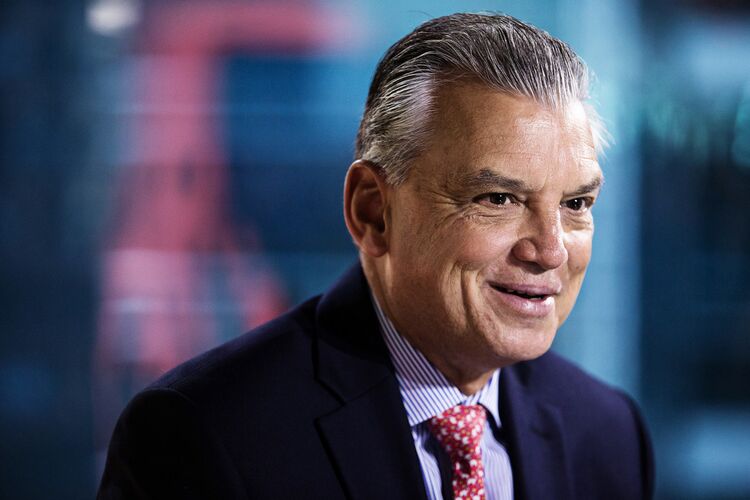Leeham News and Analysis
There's more to real news than a news release.
- Supply chain continues to bedevil Airbus, Boeing
- Bjorn’s Corner: Faster aircraft development. Part 19. Flight Test Aircraft Assembly.
- Comments on freewall posts are closed for now
- The state of alternative propulsion aircraft? Part 4.
- Boeing CFO Jay Malave: Priorities are debt, investments, then shareholders
Embraer faces new challenge from MRJ90
Part 2

Paulo Cesar, president and CEO of Embraer’s commercial aviation unit. Photo via Google images.
Sept. 10, 2015, © Leeham Co. Embraer is the dominant producer of commercial aircraft in the 70-125 seat sector, having overtaken Bombardier in the last decade following the development and 2004 introduction of the E-Jet. Bombardier’s CRJ family struggles, hampered by a sales force that neglected it and the Q400 turbo-prop as attention focused on the new CSeries.
Embraer in recent years faced new competition. However, the early entries—AVIC’s ARJ21 and the Sukhoi Superjet SJ100, both in the 70-90 seat sector, proved little to worry about. The ARJ21, now eight years late, proved to be a technological and industrial dud, a project that was more about learning how to design and build an airplane than producing a commercially viable one.
The SSJ100, while winning favorable reviews, was and continues to be plagued by a poor production system and in recent years the political overhang of Russia’s annexation of Crimea and its war in Ukraine.
Shortly, though, the E-190 faces a new challenger: the Mitsubishi MRJ90. It’s two years late, now forecasting an entry-into-service of 2017—just one year ahead of the redesigned E-190, the E-190 E2. The MRJ90, a 90-seat clean-sheet design, is Japan’s first commercial airliner since the NAMC YS-11 turbo-prop of the 1960s. The MRJ90’s first flight is scheduled for the second half of next month. Full flight testing moves to Washington State in the first quarter next year.
Posted on September 10, 2015 by Scott Hamilton
Airbus, Airlines, Boeing, Bombardier, CSeries, Embraer, Lockheed Martin, McDonnell Douglas, Mitsubishi
767, A320, A400M, Airbus, Boeing 737, Bombardier, C-130, CRJ, E-175, E-175-E2, E-190, E-190 E2, E-195, E-Jet, Embraer, International Aero Engines, KC-390, Lockheed Martin, McDonnell Douglas, MD-90, Mitsubishi, MRJ90, Paulo Cesar, Q400, SkyWest Airlines, Trans States Airlines, V2500
Odds and Ends: KC-390 first flight; A400M; AirAsia 8501; Bombardier credibility
KC-390 first flight: Embraer’s largest airplane ever built, the KC-390 tanker/transport, made its first flight today.
We profiled the airplane last October following our visit to Brazil.
The airplane fulfills needs for Brazil’s vast geography to supply its population and to serve as a military platform. It also gives EMB valuable experience in developing large aircraft. The cross-section is about the size of a Boeing 767. It’s slightly larger than a Lockheed Martin C-130 but smaller than the Airbus A400M.
Speaking of A400M: Tom Enders, CEO of Airbus Group, had some comments about this problem child at Airbus in his annual press conference dinner in Paris. Aviation Week reports.
AirAsia 8501: Reuters reported last week two unidentified sources said the captain was out of his seat cutting power to two computers, working a flaw, when AirAsia flight 8501 went out of control and crashed into the Java Sea. Now there’s a report disputing this.
Bombardier credibility: Ahead of the Feb. 12 year end 2014 earnings call, Bloomberg News has a story that focuses on Bombardier’s credibility issues with investors. CEO Pierre Beaudoin has his work cut out for him on the call to reassure investors.
Posted on February 3, 2015 by Scott Hamilton
Airbus A400M; how good and how late?
Subscription required
By Bjorn Fehrm
Introduction
01 Feb 2015: Six years ago Tom Enders, then-CEO for Airbus (when the parent was named EADS), threatened to stop the A400M project. He then played hardball to get eight European states to understand they had to pay 5bn Euro more or get no plane. Airbus existence could be threatened by a project that its management when the program was launch (CEO Jean Pierson) did not want but that the politicians convinced Pierson’s successor, Noel Forgeard, to do.
Now Tom Enders is CEO of Airbus Group and has to apologize to the same governments that he struck a deal with then to finish the project if Airbus got the money and a consent to three years of delays. Now Airbus can no longer fulfill the terms and the airplane is still falling short of performance specifications. Deliveries have been delayed further and promised capabilities will be delivered later than said. Like then, heads are rolling at Airbus and tighter control is being applied.
Summary
- The A400M rests between the Lockheed Martin C-130 and the Boeing C-17.
- European countries need an airlifter for military and humanitarian missions.
- Dirt airstrip capability is needed.
- The program will take longer to complete and this time Airbus has to pay.
Posted on February 1, 2015 by Bjorn Fehrm
Airbus, Boeing, EADS, Lockheed Martin, MTU, Premium, Rolls-Royce
A400M, Airbus, Boeing, C-130, C-17, EADS, Lockheed Martin, Rolls-Royce


